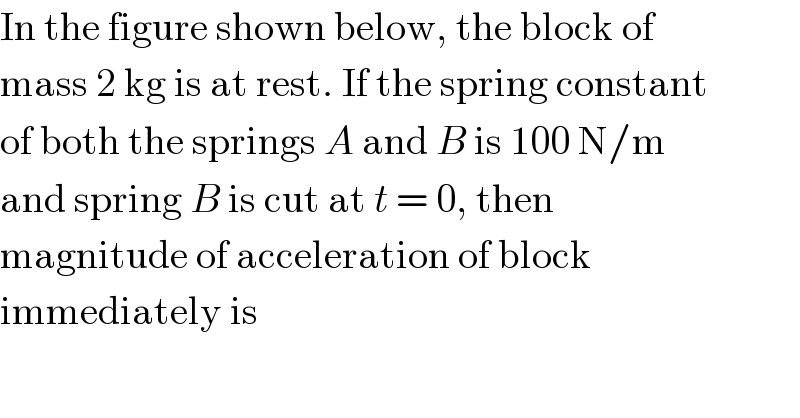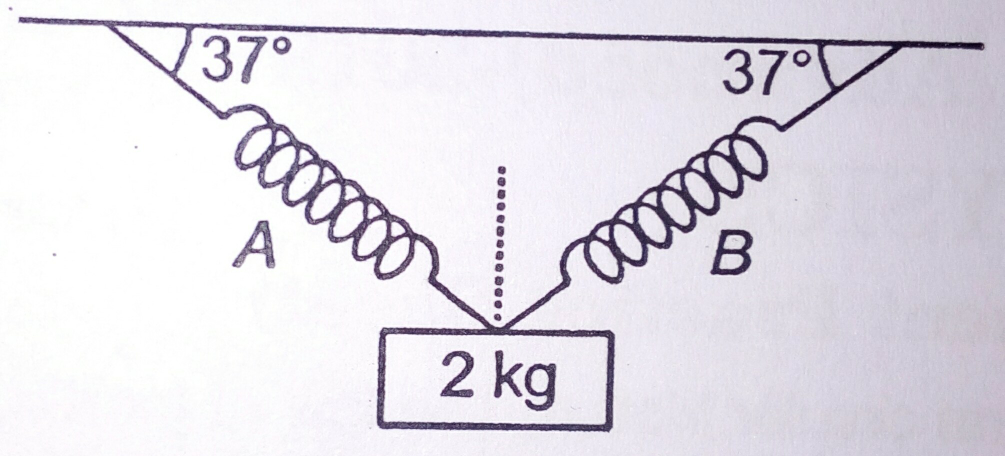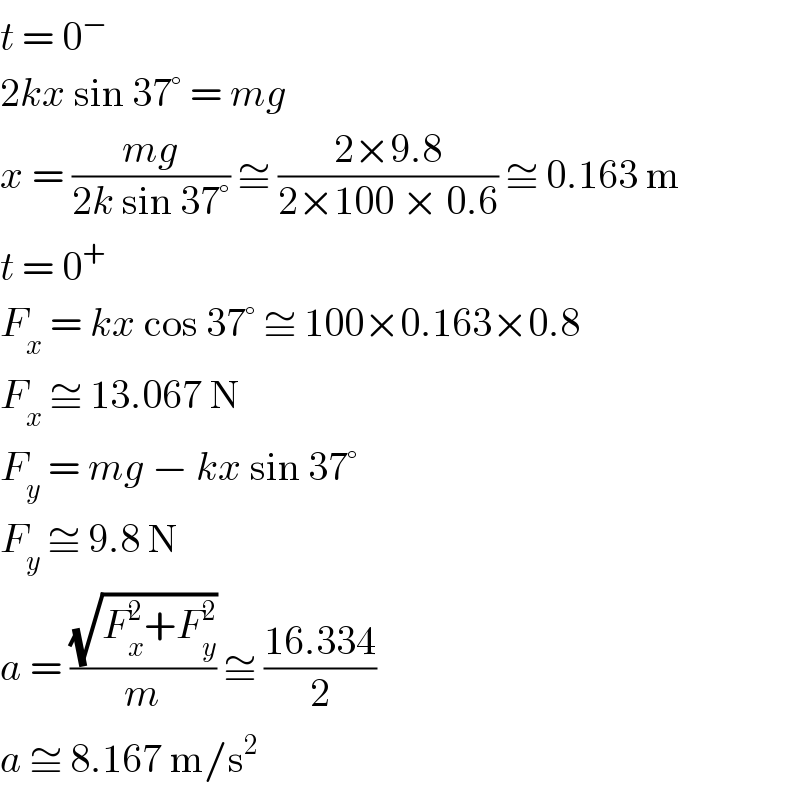
Question Number 20989 by Tinkutara last updated on 09/Sep/17

$$\mathrm{In}\:\mathrm{the}\:\mathrm{figure}\:\mathrm{shown}\:\mathrm{below},\:\mathrm{the}\:\mathrm{block}\:\mathrm{of} \\ $$$$\mathrm{mass}\:\mathrm{2}\:\mathrm{kg}\:\mathrm{is}\:\mathrm{at}\:\mathrm{rest}.\:\mathrm{If}\:\mathrm{the}\:\mathrm{spring}\:\mathrm{constant} \\ $$$$\mathrm{of}\:\mathrm{both}\:\mathrm{the}\:\mathrm{springs}\:{A}\:\mathrm{and}\:{B}\:\mathrm{is}\:\mathrm{100}\:\mathrm{N}/\mathrm{m} \\ $$$$\mathrm{and}\:\mathrm{spring}\:{B}\:\mathrm{is}\:\mathrm{cut}\:\mathrm{at}\:{t}\:=\:\mathrm{0},\:\mathrm{then} \\ $$$$\mathrm{magnitude}\:\mathrm{of}\:\mathrm{acceleration}\:\mathrm{of}\:\mathrm{block} \\ $$$$\mathrm{immediately}\:\mathrm{is} \\ $$
Commented by Tinkutara last updated on 09/Sep/17

Answered by dioph last updated on 09/Sep/17

$${t}\:=\:\mathrm{0}^{−} \\ $$$$\mathrm{2}{kx}\:\mathrm{sin}\:\mathrm{37}°\:=\:{mg} \\ $$$${x}\:=\:\frac{{mg}}{\mathrm{2}{k}\:\mathrm{sin}\:\mathrm{37}°}\:\cong\:\frac{\mathrm{2}×\mathrm{9}.\mathrm{8}}{\mathrm{2}×\mathrm{100}\:×\:\mathrm{0}.\mathrm{6}}\:\cong\:\mathrm{0}.\mathrm{163}\:\mathrm{m} \\ $$$${t}\:=\:\mathrm{0}^{+} \\ $$$${F}_{{x}} \:=\:{kx}\:\mathrm{cos}\:\mathrm{37}°\:\cong\:\mathrm{100}×\mathrm{0}.\mathrm{163}×\mathrm{0}.\mathrm{8} \\ $$$${F}_{{x}} \:\cong\:\mathrm{13}.\mathrm{067}\:\mathrm{N} \\ $$$${F}_{{y}} \:=\:{mg}\:−\:{kx}\:\mathrm{sin}\:\mathrm{37}° \\ $$$${F}_{{y}} \:\cong\:\mathrm{9}.\mathrm{8}\:\mathrm{N} \\ $$$${a}\:=\:\frac{\sqrt{{F}_{{x}} ^{\mathrm{2}} +{F}_{{y}} ^{\mathrm{2}} }}{{m}}\:\cong\:\frac{\mathrm{16}.\mathrm{334}}{\mathrm{2}} \\ $$$${a}\:\cong\:\mathrm{8}.\mathrm{167}\:\mathrm{m}/\mathrm{s}^{\mathrm{2}} \\ $$
Commented by Tinkutara last updated on 13/Sep/17

$$\mathrm{But}\:\mathrm{spring}\:\mathrm{force}\:\mathrm{does}\:\mathrm{not}\:\mathrm{disappear} \\ $$$$\mathrm{immediately},\:\mathrm{then}\:\mathrm{why}\:\mathrm{you}\:\mathrm{have} \\ $$$$\mathrm{neglected}\:{F}_{{x}} \:=\:{kx}\:\mathrm{cos}\:\mathrm{37}°\:\mathrm{due}\:\mathrm{to}\:\mathrm{spring} \\ $$$${B}? \\ $$
